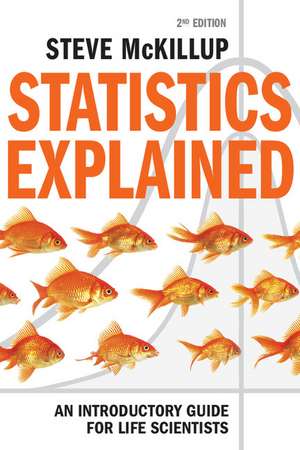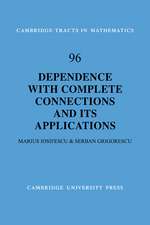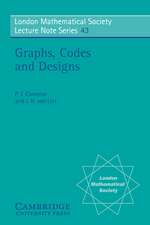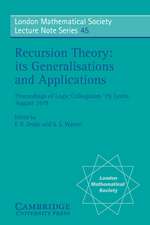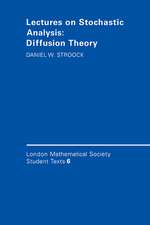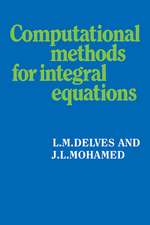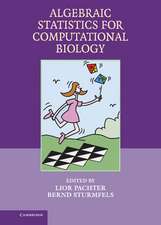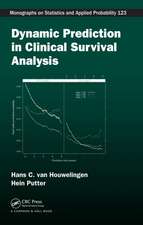Statistics Explained: An Introductory Guide for Life Scientists
Autor Steve McKillupen Limba Engleză Paperback – 2 noi 2011
| Toate formatele și edițiile | Preț | Express |
|---|---|---|
| Paperback (1) | 327.88 lei 6-8 săpt. | |
| Cambridge University Press – 2 noi 2011 | 327.88 lei 6-8 săpt. | |
| Hardback (1) | 712.28 lei 6-8 săpt. | |
| Cambridge University Press – 2 noi 2011 | 712.28 lei 6-8 săpt. |
Preț: 327.88 lei
Nou
Puncte Express: 492
Preț estimativ în valută:
62.75€ • 68.13$ • 52.71£
62.75€ • 68.13$ • 52.71£
Carte tipărită la comandă
Livrare economică 22 aprilie-06 mai
Preluare comenzi: 021 569.72.76
Specificații
ISBN-13: 9780521183284
ISBN-10: 0521183286
Pagini: 416
Ilustrații: 199 b/w illus. 102 tables 51 exercises
Dimensiuni: 152 x 228 x 19 mm
Greutate: 0.66 kg
Ediția:2nd edition.
Editura: Cambridge University Press
Colecția Cambridge University Press
Locul publicării:Cambridge, United Kingdom
ISBN-10: 0521183286
Pagini: 416
Ilustrații: 199 b/w illus. 102 tables 51 exercises
Dimensiuni: 152 x 228 x 19 mm
Greutate: 0.66 kg
Ediția:2nd edition.
Editura: Cambridge University Press
Colecția Cambridge University Press
Locul publicării:Cambridge, United Kingdom
Cuprins
Preface; 1. Introduction; 2. Doing science: hypotheses, experiments and disproof; 3. Collecting and displaying data; 4. Introductory concepts of experimental design; 5. Doing science responsibly and ethically; 6. Probability helps you make a decision about your results; 7. Probability explained; 8. Using the normal distribution to make statistical decisions; 9. Comparing the means of one and two samples of normally distributed data; 10. Type 1 and Type 2 error, power and sample size; 11. Single factor analysis of variance; 12. Multiple comparisons after ANOVA; 13. Two-factor analysis of variance; 14. Important assumptions of analysis of variance, transformations and a test for equality of variances; 15. More complex ANOVA; 16. Relationships between variables: correlation and regression; 17. Regression; 18. Analysis of covariance; 19. Non-parametric statistics; 20. Non-parametric tests for nominal scale data; 21. Non-parametric tests for ratio, interval or ordinal scale data; 22. Introductory concepts of multivariate analysis; 23. Choosing a test; Appendix: critical values of chi-square, t and F; References; Index.
Recenzii
'Every so often, a researcher or teacher comes across a book and exclaims 'I wish I had had a book like this when I started!' … Statistics Explained is such a book. Steve McKillup writes with empathy for students' anxiety about statistics. He replaces complex-looking formulae with graphics and realistic examples. He is a biologist writing for fellow-biologists … [The book] explains why the statistical test is needed before describing the test. Essential features of good survey and experimental design are clearly outlined … This is not 'just another biostatistics textbook'. Its sheer readability will restore confidence to the most anxious student while experienced researchers will savour the clarity of the explanations of the common univariate and multivariate analyses … an ideal core text for anyone teaching or studying biostatistics …' Andrew Boulton, University of New England, Australia
'It's remarkable that, after the appearance of many statistics textbooks and statistics computer packages over the years, finally someone has produced a succinct and accessible text that takes a common-sense and appealing approach to the basics of statistical analysis. Complementing Steve McKillup's remarkably lucid explanations is a format which sings pleasingly with clarity. The book progresses in logical fashion through the variety of statistical tests and gives the reader a sound background in the process without the common dizzying confusion. The narrative style and informative approach has made my copy a much-travelled item from my bookshelf to the shores of both undergraduate confusion and postgraduate clarification. However, I always make sure it comes back because it [is] a valued item in my biology toolkit.' Michael Kokkinn, University of South Australia
'Statistics Explained is an excellent introduction to statistics for new students and a helpful refresher for more seasoned researchers. The text is quite readable and filled with practical examples for the life sciences.' Erin D. Sheets, University of Minnesota College of Pharmacy
'Most exciting perhaps are the topics covered that are not often discussed in introductory textbooks … I have no doubt that Statistics Explained will find a large and appreciative audience among undergraduate biology majors.' The Quarterly Review of Biology
'It's remarkable that, after the appearance of many statistics textbooks and statistics computer packages over the years, finally someone has produced a succinct and accessible text that takes a common-sense and appealing approach to the basics of statistical analysis. Complementing Steve McKillup's remarkably lucid explanations is a format which sings pleasingly with clarity. The book progresses in logical fashion through the variety of statistical tests and gives the reader a sound background in the process without the common dizzying confusion. The narrative style and informative approach has made my copy a much-travelled item from my bookshelf to the shores of both undergraduate confusion and postgraduate clarification. However, I always make sure it comes back because it [is] a valued item in my biology toolkit.' Michael Kokkinn, University of South Australia
'Statistics Explained is an excellent introduction to statistics for new students and a helpful refresher for more seasoned researchers. The text is quite readable and filled with practical examples for the life sciences.' Erin D. Sheets, University of Minnesota College of Pharmacy
'Most exciting perhaps are the topics covered that are not often discussed in introductory textbooks … I have no doubt that Statistics Explained will find a large and appreciative audience among undergraduate biology majors.' The Quarterly Review of Biology
Notă biografică
Descriere
This book provides straightforward conceptual explanations of statistical methods for the life sciences, specially designed for students lacking a strong mathematical background.
